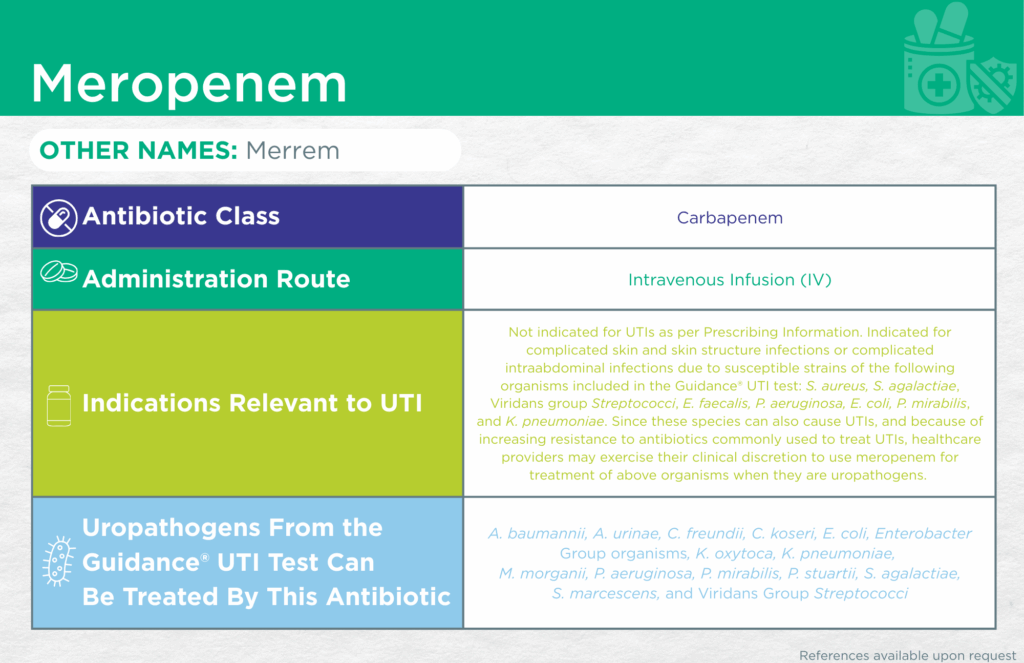Meropenem

Emery Haley, PhD, Scientific Writing Specialist
Meropenem
Find the Latest FDA-Approved Labelling Information Here: Drugs@FDA Online Database
Administrative Routes
Parenteral [intravenous infusion (IV)]
Other Names
Merrem
Bacteriostatic or Bactericidal
Bactericidal [1]
Antibiotic Class
Carbapenem
Mechanisms of Action
Meropenem, a beta-lactam antibiotic, binds to penicillin-binding proteins (PBPs) on bacterial cell walls. PBPs are essential for the formation of the peptidoglycan, which gives the bacterial wall strength and integrity. Binding of meropenem to PBPs leads to failure of peptidoglycan cell wall synthesis, causing bacterial cell death.
WHO AWaRe Classification
Watch [2]
Empiric Use Recommendations
Yes (preferred for complicated UTI with sepsis; alternative for complicated UTI without sepsis) [Infectious Diseases Society of America (IDSA)] [3]
Indication(s) Relevant to UTI
Not indicated for UTIs as per Prescribing Information.
Indicated for complicated skin and skin structure infections or complicated intraabdominal infections due to susceptible strains of the following organisms included in the Guidance® UTI test: Staphylococcus aureus, Streptococcus agalactiae, Viridans group Streptococci, Enterococcus faecalis, Pseudomonas aeruginosa, Escherichia coli, Proteus mirabilis, and Klebsiella pneumoniae.
Since these species can also cause UTIs, and because of increasing resistance to antibiotics commonly used to treat UTIs, healthcare providers may exercise their clinical discretion to use meropenem for treatment of above organisms when they are uropathogens.
Checkmarks
CLSI and/or FDA documents support the efficacy of this antibiotic against the following organisms from the Guidance® UTI test: Acinetobacter baumannii, Aerococcus urinae, Citrobacter freundii, Citrobacter koseri, Escherichia coli, Enterobacter Group organisms, Klebsiella oxytoca, Klebsiella pneumoniae, Morganella morganii, Pseudomonas aeruginosa, Proteus mirabilis, Providencia stuartii, Streptococcus agalactiae, Serratia marcescens, and Viridans Group Streptococci.
- Ishak, A.; Mazonakis, N.; Spernovasilis, N.; Akinosoglou, K.; Tsioutis, C. Bactericidal versus Bacteriostatic Antibacterials: Clinical Significance, Differences and Synergistic Potential in Clinical Practice. J. Antimicrob. Chemother. 2024, 80, 1–17, doi:10.1093/jac/dkae380
- AWaRe Classification of Antibiotics for Evaluation and Monitoring of Use, 2023 Available online: https://www.who.int/publications/i/item/WHO-MHP-HPS-EML-2023.04 (accessed on 6 February 2025).
- Complicated Urinary Tract Infections (CUTI): Clinical Guidelines for Treatment and Management Available online: https://www.idsociety.org/practice-guideline/complicated-urinary-tract-infections/ (accessed on 28 July 2025).
Dr. Emery Haley is a scientific writing specialist with over ten years of experience in translational cell and molecular biology. As both a former laboratory scientist and an experienced science communicator, Dr. Haley is passionate about making complex research clear, approachable, and relevant. Their work has been published in over 10 papers and focuses on bridging the gap between the lab and real-world patient care to help drive better health outcomes.